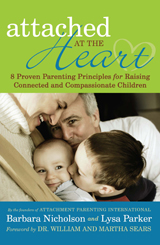Attachment Parenting Month 2013 is here! With this year’s theme of “Parenting Creatively: The Art of Parenting” in mind, we are pleased to share this article by reader Ariadne Brill, who blogs at positiveparentingconnection.net.
 If you have read about the benefits of skipping time-out in favor of other ways to guide children but are not sure where to start, here are 12 alternatives to time-out that give parents and children a chance to address choices and situations with the intention to offer guidance while maintaining a positive, respectful and peaceful connection.
If you have read about the benefits of skipping time-out in favor of other ways to guide children but are not sure where to start, here are 12 alternatives to time-out that give parents and children a chance to address choices and situations with the intention to offer guidance while maintaining a positive, respectful and peaceful connection.
These alternatives are mostly geared towards children aged 1 to 6 years but also work well beyond that, too.
1. Take a break together. The key is to do this together and before things get out of hand. So if your child is having a difficult time or making unsafe choices like hitting a playmate, find a quiet space to take a break together. Just five minutes of connection, listening to what your child is feeling and talking about more appropriate choices really helps. This is similar to a time-in.
2. Second chances. Ever made a mistake and felt so relieved to have a chance at a do-over? Often letting children try again lets them address the problem or change their behavior. “I can’t let you put glue all over the table. Do you want to try this again on paper?”
3. Problem solve together. If there is a problem and your child is acting out of frustration, giving him a chance to talk about the problem and listening to a solution he has can turn things around for the better.
4. Ask questions. Sometimes children do things but we don’t quite get it. We might assume incorrectly they are doing something “bad” or “naughty” when, in fact, they are trying to understand how something works. Ask what they are up to with the intent to listen and understand first, then correct them by providing the appropriate outlet or information that is missing. So try, “What are you trying to do?” instead of, “Why in the world…ugh!!! Time out!”
5. Read a story. Another great way to help children understand how to make better choices is by reading stories with characters that are making mistakes, having big feelings or needing help to make better choices. Also, reading together can be a really positive way to reconnect and direct our attention to our child.
6. Puppets & play. Young children love to see puppets or dolls come to life to teach positive lessons. “I’m Honey Bear, and oh, it looks like you scribbled crayons on the ground. I’m flying to the kitchen to get a sponge for us to clean it up together. Come along!” After cleaning up together, “Oh, now let’s fetch some paper, and will you color me a picnic on the paper? Paper is for coloring with crayons!”
7. Give two choices. Let’s say your child is doing something completely unacceptable. Provide her with two alternatives that are safe, respectful and acceptable, and let her choose what she will do from there. By receiving two choices, the child can keep some control over her decisions while still learning about boundaries.
8. Listen to a song. Sometimes taking a fun break to release some tension and connect is all that children need to return to making better choices and all that parents need to loosen up a bit and let go of some stress. Listen to a song or take a dance break!
9. Go outside. Changing locations often gives us parents a chance to redirect behavior to something more appropriate. “I cannot let you scale the bookshelf. You CAN climb on the monkey bars. Let’s go outside and practice that instead!” Or, “Cutting the carpet with the scissors is not acceptable. Let’s go outside and cut some grass.”
10. Breathe. A big, deep breath for both parents and children can really help us calm down and look at what is going on with a new perspective. Take a big “lion” breath to get out frustrations or short and quick “bunny” breaths to feel calm and re-energized.
11. Draw a picture. A wonderful way for children to talk about mistakes is to make a picture of what they did or could have done differently. It’s a low-key way to open a window for talking to each other about making better choices.
12. Chill-out space. For a time-out to work, it needs to be something that helps everyone calm down, not something that makes children frightened or scared. A chill-out space is an area where children can go sit and think, tinker with some quiet toys, and have some space alone until they feel ready to talk or return to being with others. Using the chill-out space should be offered as a choice and not a command.
Every child and every situation is unique, so these tools are not one-size-fits-all but rather a list of ideas to lean on to expand your parenting toolbox. I find that striving to use proactive tools like these to respond to and to guide children towards better choices works far more positively than having to react when things have gotten out of hand.








